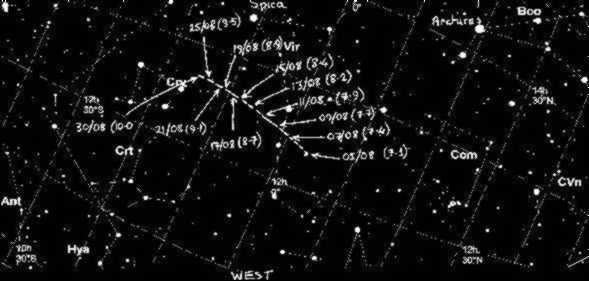The M.A.S.
Newsletter
Journal of the
Mauritius Astronomical Society
August 2000
The Next Meeting:
The next meeting will be due
Thursday 10th of August for a visit to the Mauritius Radio Telescope (MRT) at
Bras d'Eau. We shall be meeting at 17:00 at Collège du Saint Esprit, from where we will
drive to Bras d'Eau. Members wishing to offer a place in their vehicle are kindly
requested to inform us at the following:
Mr. Ricaud Auckbur: 466 5932
Mr. Bhasker Desai: 454 1472
Myself:
686 4396
Members wishing to come on that date but
not having their own means of transport are also kindly requested to inform us (above) so
that the necessary arrangements be made. Note that the meeting of the 25th of
August has been cancelled
The sky this month:
The a-Capricornids, which often
produces long slow fireballs, reaches peak activity on the night of Wednesday the 2nd
of August. It is best observed from 00:00 to 04:00 on Thursday. Another shower, the i-Aquarids peaks
on Sunday the 6th of August. The Moon will not interfere with both showers.
Unfortunately, both showers have a low Zenithal Hourly Rate (ZHR) of less than 10. The i-Aquarids
shower is rich in faint meteors. The radiant (i.e the point among the stars from which the
trails of the meteors appear to come) of both these showers are very high in our sky at
the time of peak activity.
Shining brightly at magnitude - 3.9, Venus
is back in the evening sky. On the 20th of August it is in the constellation of
Leo and sets at 19:21. The planets Jupiter and Saturn are both in the constellation
of Taurus between the Hyades and the Pleiades. On the 20th,
Saturn rises at 00:37 while Jupiter at 01:14.
Comet LINEAR (C/1999 S4):
As from the beginning of August the
fading comet can be seen best from the southern hemisphere. Southern observers with access
to a small telescope are in for a treat on August 20th when the comet passes close to the
Sombrero galaxy (M104). From Mauritius LINEAR S4 will pass right in front of M104,
affording an opportunity for truly unique astrophotos. The map, shows the western sky on
the 15th of August at 19:00. The approximate position of the comet during the
month of August is also shown relative to the constellations. Note that the comet is too
faint (above magnitude 6) to allow for naked eye observation. With a pair of binoculars,
one can expect to see up to magnitude 10. On the map below the expected magnitude is shown
in brackets ( ) next to the date. Remember, the higher the magnitude number, the dimmer
the comet! Good luck!
News:
Astronomers announced Tuesday 18th
July that they have seen for the first time a flare from a brown dwarf, a class of failed
star thought to be free of such activity. In a paper to be published in the July 20 issue
of Astrophysical Journal Letters, a group of astronomers reported that brown dwarf LP
944-20 suddenly brightened at x-ray wavelengths during a 12-hour observation by the
Chandra X-ray Observatory December 15. The flare was likely triggered by activity beneath
the surface of the dwarf, 60 times as massive as Jupiter. "The flare was a
bonus," Gibor Basri of the University of California Berkeley said. "We've shown
that older brown dwarfs don't have coronae, but the flare tells us they still have
magnetic fields and also that subsurface flares occasionally punch through into the
atmosphere."
Serge Florens,
Secretary
Back to Archives

